Proposed Mearns Quail Research Project

Male Mearns Quail
Diet composition of the Montezuma quail in southeastern Arizona and southwestern New Mexico during the winter
Principal Investigator: Dr. Alberto Macías-Duarte
Academic Group of Natural Resources, Universidad Estatal de Sonora, Ley Federal del Trabajo S/N, Col. Apolo, Hermosillo, Sonora 83100 Mexico.
Justification
The Montezuma quail is a charismatic species highly valued by birdwatchers and as game in Arizona and New Mexico at the northern edge of the species’ geographic distribution. Montezuma quail are a year-round resident of pine, oak and pine-oak woodlands with an important native perennial grass component. The species geographic range comprises suitable habitat from Arizona, New Mexico, and Texas south along the Sierra Madre woodlands of Mexico to Oaxaca. The highly secretive behaviour of Montezuma quail hinders researchers’ capabilities to monitor the species and therefore determine current population status and population trajectories that allow its proper conservation and management. Still, the specific habitat requirements of Montezuma quail reveal relevant aspects useful to management. The requirement of grassy vegetation is strongly associated with the availability of this quail’s food sources. Montezuma quail are primarily a ground feeder; acorns (Quercus spp.) and underground tubers (Oxalis spp., Cyperus spp.) constitute nearly 80% of diet year-round. Seeds of Panicum spp., Ipomoea spp., Solanum spp., Brodiaea spp., yucca, and Lupinus spp. are also important. Insects are key items in summer, especially grasshoppers, ants, and beetles. Although the diet of Montezuma quail seems simple, the feeding ecology of this quail is poorly known. In addition, the study of the species’ diet during the non-growing season (i.e. winter) is highly relevant to understand their feeding ecology. Winter may limit its’ prefered food and thus may reveal the ecological processes limiting the abundance of the species more efficiently.
In this regard, the present project aims to provide basic information on diet composition on Montezuma quail during the winter at the northern edge of the species distribution. By investigating the feeding ecology of Montezuma quail, we may address the demographic consequences of a more arid southwestern United States in the coming decades as predicted by General Circulation Models by investigating the changes introduced to their food source.
Objectives
- Determine the composition and nutritional value of Montezuma quail’s diet from crop contents in individuals harvested in southeastern Arizona and southwestern New Mexico.
- Estimate the effects of climate change on Montezuma quail’s food resources to model changes in the species’ future distribution in its northern edge.
Methodology
We will conduct the analysis of quail diet by identifying all food items in approximately 150 crops from quail harvested during the hunting season (November-February) in southeastern Arizona and southwestern New Mexico since 2008. We will produce a reference collection from photographs in the scientific literature and from specimens from the field. In addition, we will conduct bromatological analysis to determine the nutritional value of food items and their temporal (within-day and within season) and spatial variation. These measurements will allow us to determine what nutrients are limited in the quail’s diet. This work will be conducted in the Laboratory of Nutrition of Universidad Estatal de Sonora. The determination of plant species composition in crop contents will allow us to model Montezuma quail distribution under different scenarios of climate change by modeling the distribution of the plant species part of the quail’s diet.
Budget
We will conduct this project with two main sources of funding: 1) US partners $13,500 in analysis of quail crops (composition and bromatological analysis), field supplies, and data collection. 2) The National Council of Science and Technology of Mexico (CONACyT analogous to NSF in the USA) will provide a two-year scholarship to a M.Sc. student to conduct this study under the supervision of Dr. Macías (quail biology) and my collaborator, Dr. Ortega (climate change). The following table shows the funding breakdown:
Timeline
We will conduct the analysis of all quail crops from the Fall of 2015 to the Spring of 2017, i.e. the duration of a master’s degree program.
Products
This project will allow a Mexican student to obtain a master’s degree from Universidad Estatal de Sonora and submittal of at least one peer-reviewed publication in a wildlife management or ornithological journal. This information will become a valuable tool for the management and conservation of the species.

